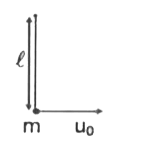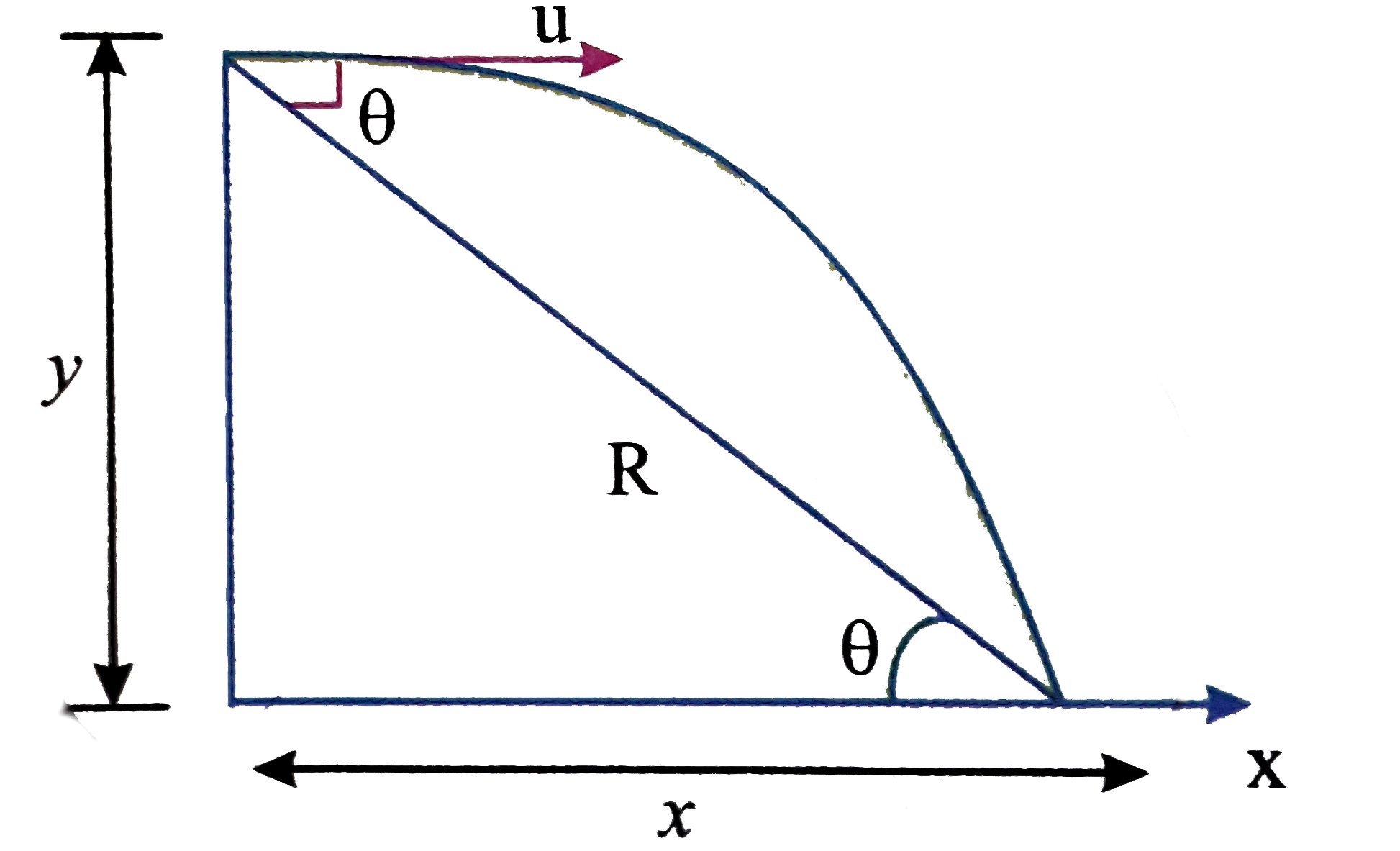A heavy particle hanging from a fixed point by a light inextensible string of length l is projected horizontally with speed (gl) . Then the speed of the particle and the inclination of the string to the vertical at the instant of the motion when the tension in the string equal the weight of the particle-
To solve the problem, we will follow these steps:
Step 1: Understand the problem
We have a heavy particle hanging from a fixed point by a light inextensible string of length l. The particle is projected horizontally with a speed √gl. We need to find the speed of the particle and the angle θ of the string with the vertical when the tension in the string equals the weight of the particle.
Step 2: Set up the equations of motion
At the instant when the tension T in the string equals the weight mg of the particle, we can use the following equations:
1. The vertical forces give us:
T−mgcosθ=mv2r
where r=l (the length of the string) and v is the speed of the particle.
2. The height h of the particle above the lowest point can be expressed as:
h=l−lcosθ=l(1−cosθ)
The potential energy change gives us:
v2=u2−2gh
where u=√gl (initial speed).
Step 3: Substitute values
Substituting for h:
v2=(√gl)2−2g(l(1−cosθ))
This simplifies to:
v2=gl−2gl(1−cosθ)=gl−2gl+2glcosθ=−gl+2glcosθ
Thus:
v2=gl(2cosθ−1)
Step 4: Set the tension equation
From the tension equation, substituting T=mg:
mg−mgcosθ=mv2l
Cancelling m from both sides:
g−gcosθ=v2l
Thus:
v2=l(g−gcosθ)=gl(1−cosθ)
Step 5: Equate the two expressions for v2
Now, we have two expressions for v2:
1. v2=gl(2cosθ−1)
2. v2=gl(1−cosθ)
Setting them equal to each other:
gl(2cosθ−1)=gl(1−cosθ)
Cancelling gl (assuming g≠0 and l≠0):
2cosθ−1=1−cosθ
Rearranging gives:
3cosθ=2⟹cosθ=23
Step 6: Find θ
Now we can find θ:
θ=cos−1(23)
Step 7: Find v
Substituting cosθ back into one of the equations for v2:
v2=gl(1−23)=gl⋅13=gl3
Thus:
v=√gl3
Final Answers
- The angle θ=cos−1(23)
- The speed v=√gl3
We have a heavy particle hanging from a fixed point by a light inextensible string of length l. The particle is projected horizontally with a speed √gl. We need to find the speed of the particle and the angle θ of the string with the vertical when the tension in the string equals the weight of the particle.
At the instant when the tension T in the string equals the weight mg of the particle, we can use the following equations:
T−mgcosθ=mv2r
where r=l (the length of the string) and v is the speed of the particle.
h=l−lcosθ=l(1−cosθ)
The potential energy change gives us:
v2=u2−2gh
where u=√gl (initial speed).
Substituting for h:
v2=(√gl)2−2g(l(1−cosθ))
This simplifies to:
v2=gl−2gl(1−cosθ)=gl−2gl+2glcosθ=−gl+2glcosθ
Thus:
v2=gl(2cosθ−1)
From the tension equation, substituting T=mg:
mg−mgcosθ=mv2l
Cancelling m from both sides:
g−gcosθ=v2l
Thus:
v2=l(g−gcosθ)=gl(1−cosθ)
Now, we have two expressions for v2:
1. v2=gl(2cosθ−1)
2. v2=gl(1−cosθ)
gl(2cosθ−1)=gl(1−cosθ)
Cancelling gl (assuming g≠0 and l≠0):
2cosθ−1=1−cosθ
Rearranging gives:
3cosθ=2⟹cosθ=23
Now we can find θ:
θ=cos−1(23)
Substituting cosθ back into one of the equations for v2:
v2=gl(1−23)=gl⋅13=gl3
Thus:
v=√gl3
- The angle θ=cos−1(23)
- The speed v=√gl3
Topper's Solved these Questions
- CIRCULAR MOTIONBook:DC PANDEY ENGLISHChapter:CIRCULAR MOTIONExercise:Solved Examples
Explore 2 Videos
- CIRCULAR MOTIONBook:DC PANDEY ENGLISHChapter:CIRCULAR MOTIONExercise:Miscellaneous Examples
Explore 5 Videos
- CENTRE OF MASS, LINEAR MOMENTUM AND COLLISIONBook:DC PANDEY ENGLISHChapter:CENTRE OF MASS, LINEAR MOMENTUM AND COLLISIONExercise:Level 2 Subjective
Explore 21 Videos
- COMMUNICATION SYSTEMBook:DC PANDEY ENGLISHChapter:COMMUNICATION SYSTEMExercise:Only One Option is Correct
Explore 27 Videos
Similar Questions
A heavy particle hanging from a fixed point by a light inextensible string of length l is projected horizonally with speed √gl . Find the speed of the particle and the inclination of the string to the vertical at the instant of the motion when the tension in the string is equal to the weight of the particle.
View SolutionA heavy particle hanging from a string of length I is projected horizontally with speed √gl . Find the speed of the particle at the point where the tension in the string equals weight of the particle.
View SolutionA stone hanging from a massless string of length 15m is projected horizontally with speed √147ms−1 Then the Speed of the particle, at the point where tension in string equals the weight of particle, is
View SolutionA stone hanging from a massless string of length 15 m is projected horizontally with speed 12ms−1. The speed of the particle at the point where the tension in the string is equal to the weight of the particle, is close to
View SolutionThe bob hanging from a light string is projected horizontally with a speed u0. In the subsequent upward motion of the bob in vertically plane

View SolutionA particle suspended from a fixed point, by a light inextensible thread of length L is projected horizontally from its lowest position with velocity 7gL . The thread will slack after swinging through an angle , such that equal
View SolutionA heavy particle hangs from a point O, by a string of length a. It is projected horizontally with a velocity u=√(2+√3)ag . The angle with the downward vertical, string makes where string becomes slack is :
View SolutionA particle is fastened at the end of a string and whirled in a vertical circle with the other end of the string being fixed. The motion of the particle is
View SolutionA particle is projected horizontally with a speed u from the top of plane inclined at an angle θ with the horizontal. How far from the point of projection will the particle strike the plane ?

View SolutionA particle of mass m is tied to a string of length L and whirled into a horizontal plan. If tension in the string is T then the speed of the particle will be :
View Solution